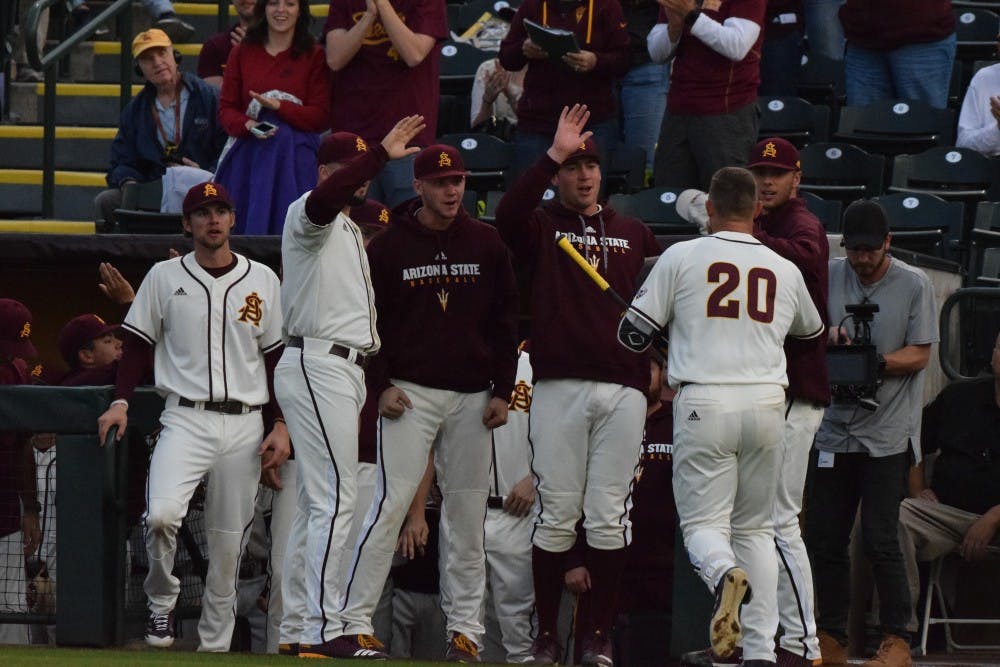As it currently stands, ASU’s Phoenix Municipal Stadium is one of the larger stadiums in college baseball.
The left and right field foul poles each sit 345 feet away from home plate down the lines, and a ball would need to travel over 410 feet to clear the center field wall. That’s a lot of outfield real estate.
With the fences being moved in after the conclusion of the 2018 season, however, the Sun Devils should be able to move out from behind the eight ball so to speak and take advantage of the new configuration.
“We play in a park that doesn’t have the dimensions that most parks have,” said Jeremy Hawkes, assistant director of media relations for ASU baseball. “We play in a park that was a major league ballpark. It’s almost a disadvantage to us because the field is 15 feet further than anywhere else we go.”
The former Spring Training home of the Oakland Athletics has robbed the Sun Devils of a few would-be home runs over the course of the season.
Freshman infielder Spencer Torkelson, specifically, who is tied for the most home runs in the nation with 14, has hit multiple balls to the warning track for outs at Phoenix Municipal that would’ve been home runs in most other stadiums.
Hawkes alluded to the UC Berkeley’s Andrew Vaughn, who is one of two players Torkelson is tied with for the collegiate home run lead. He mentioned how much different Vaughn’s home field is to ASU’s and the differences in power when the Sun Devils play on the road.
“(California’s) stadium is 390 (feet) to dead center,” Hawkes said. “Any pop fly (Vaughn) hits there is going to go out. We’ve played three quarters of our games at home and have just about as many home runs on the road as we do at home.”
Head coach Tracy Smith’s ultimate decision to have the fences brought in is only going to help ASU baseball moving forward, especially power hitters like the aforementioned Torkelson and sophomore catcher Lyle Lin.
The new configuration will lead to more defensive strategy, as well.
When junior outfielder Gage Canning (or really any batter with average to above-average speed) hits a ball in the gap with the current dimensions, it’s almost always a triple because of his elite speed. Post-2018, ASU and its opponents will have to make adjustments because those gaps won’t be as expansive.
“It’ll change how teams play defense as far as their outfields go,” Hawkes said. “We do hit more triples and doubles than a lot of teams. There will be a lot more emphasis on defensive assists. Right now, there’s no excitement when a ball is hit in the gap.”
The new fences will also have a positive impact recruiting.
When a power hitter from California is given the opportunity to play collegiate baseball in one of the largest parks in the country at ASU as opposed to a more hitter-friendly stadium in their home state, most of the players will take the latter.
Fortunately for ASU, Torkelson moved to Arizona from the Golden State and brought his offense with him. Once the stadium’s fences move in, Phoenix Municipal should only become more attractive to high school recruits and current Sun Devil players.
“(ASU’s current batters) are probably frustrated about the fact we didn’t do it this year,” Hawkes said jokingly.
Reach the columnist at Steven.Slobodzian@asu.edu or follow @PSlobodzianASU on Twitter.
Like The State Press on Facebook and follow @statepress on Twitter.
Editor’s note: The opinions presented in this column are the author’s and do not imply any endorsement from The State Press or its editors.
Want to join the conversation? Send an email to opiniondesk.statepress@gmail.com. Keep letters under 500 words and be sure to include your university affiliation. Anonymity will not be granted.




